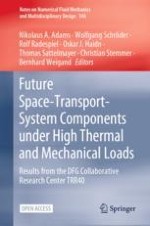1 Introduction
1.1 FSI and SWBLI
1.2 High Temperature FSI
2 Experiments on Aerothermoelastic FSI with SWBLI
2.1 Wind Tunnel H2K
2.2 Wind Tunnel Model and Instrumentation
2.3 Properties of the Elastic Panel
2.4 Experimental Results
3 Experiments on High Temperature FSI with Plastic Deformation
3.1 Arc-Heated Wind Tunnel L3K
Flow parameters | Flow composition | ||
|---|---|---|---|
Variable | Value | Species | Mass Fraction |
\(Ma_\infty \)
| 7.7 |
\(\text {N}_{\text {2}}\)
| 0.755 |
\(p_\infty \)
|
\(50.3 \, \mathrm {Pa}\)
|
\(\text {O}_{\text {2}}\)
| 0.021 |
\(T_\infty \)
|
\(477 \, \mathrm {K}\)
|
\(\text {NO}\)
| 0.022 |
\(v_\infty \)
|
\(3756 \, \mathrm {m/s}\)
|
\(\text {N}\)
|
\(<0.0001\)
|
\(\text {O}\)
| 0.202 | ||
